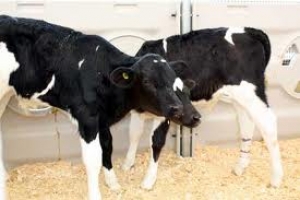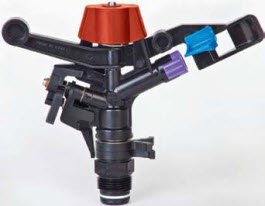Heifer care and management
Calf Health

Introduction
The aim of successful calf rearing is to produce a healthy calf which is capable of optimum performance throughout its life from birth through to finishing. A suitable calf rearing system has the following characteristics:
- Good animal performance with minimal disease and morbidity
- Low cost input
- Low labour input
To ensure a healthy calf, the aim is to minimise the calf’s exposure to disease, and maximise its defence against disease. In minimising a calf’s exposure to disease, providing a clean, disease-free environment is fundamental. This involves:
- Thorough cleaning and disinfection, before and during the calving season, of all areas used by calves.
- Providing a clean, straw-bedded lying area with no draughts and good ventilation.
- Accommodating calves in batches so that young calves are never mixed with or accommodated in areas used by older calves.
The objective of a well-designed herd health programme is to address multiple areas of management in order to reduce the likelihood of disease outbreaks and is a necessary step if economic returns are to be realised. A herd health programme that includes bio-security, vaccination and the culling of carrier animals, drawn up in consultation with a veterinary practitioner, is the best way to address disease problems.
Infectious disease agents
Calf scours
Scours are the main causes of calf mortality. The majority of calf scours are caused by six organisms: viruses such as rotavirus and coronavirus, bacteria such as E. coli and Salmonella sp., and protozoa, such as cryptosporidia and coccidia. As outlined above, vaccination of the dam will help reduce the probability of calf scours but cannot solely be depended upon for prevention.
Furthermore, there are no vaccines available to combat protozoa. However, good hygiene and management practices will reduce the likelihood of infection from cryptosporidia and coccidia. Diarrhoea in calves results in losses of water and electrolytes, such as sodium, bicarbonate, chlorine, and potassium. Calves with diarrhoea can lose 10-12 per cent of their body weight in water losses. Depending on the severity of the diarrhoea and dehydration, calves may need to receive oral electrolyte solutions once daily or as many as four times a day. Calves should be fed their regular allowance of milk when receiving oral electrolytes. Scientific evidence has accumulated that continued milk feeding does not worsen or prolong the course of diarrhoea, despite a somewhat lowered digestive capacity. The milk supplies the calf with energy and other nutrients that are essential for survival.
Calf pneumonia
The underlying cause of pneumonia or bovine respiratory disease (BRD) is extremely complex with the involvement of viruses, bacteria and mycoplasma. The incidence of infection is usually high, but the mortality rate is variable. The main viruses that cause outbreaks of pneumonia in calves are IBR, RSV, PI-3, and BVD. Factors associated with susceptibility to pneumonia in calves are; stress (disbudding, castration), overcrowding, inadequate ventilation, draughts, fluctuating temperatures, poor nutrition and/or concurrent disease. In most cases the main infective agent is a virus, which causes respiratory tract damage.
This effect is worsened by Mycoplasmas and secondary bacterial infections (e.g. Mannheimia (Pasteurella) haemolytica). Viruses are unaffected by antibiotics, however, antibiotic treatment is usually administered to kill off the secondary bacterial infections and offer the calf the opportunity to fight the disease. In order to direct the appropriate treatment strategy, nasal swabs should be submitted to the Regional Veterinary Laboratory for accurate identification of the pathogen(s) involved. Calves should be vaccinated where specific problems arise. Veterinary advice should be sought and the widest protection against pneumonia will be achieved where a vaccination programme includes the three most common respiratory viruses (IBR, RSV and PI-3) and the bacterial pathogen Mannheimia (Pasteurella) haemolytica.
Calf immunity
In the bovine species, immunoglobulins do not cross the placenta in utero, and the newborn calf is, therefore, dependent on antibodies obtained through ingestion of colostrum. Maternal colostrum provides the main source of immunoglobulins (Ig) and other nutrients for the newborn calf. If the serum immunoglobulin concentration is less than 10 mg/ml when sampled between 24 and 48 h of age, calves may be defined as having failure of passive transfer (FPT) of protective colostral immunoglobulins. Calves that receive inadequate colostrum are more susceptible to neonatal infections. This problem can be particularly severe in calves that have been moved off their farm of origin and through markets. In these circumstances, there is greater risk of exposure to infection. Foetal growth retardation or a stressful birth process is likely to reduce the ability of the intestine to absorb immunoglobulins from colostrum.
Variation in immunoglobulin concentration
Immunoglobulins help to maintain the animal’s health and reduce mortality rates by helping to eliminate foreign agents in the body (e.g. bacteria and viruses). Considerable variation exists between cows with respect to immunoglobulin concentration in the colostrum. No significant difference between colostrum IgG1 concentrations in either the front or hindquarters of the udder have been reported however, a large variation in colostrum yield exists between beef and dairy cows (Table 1). Research at Teagasc, Grange has clearly shown that dairy calves with low levels of immunoglobulins had the highest incidence of diarrhoea, respiratory disease and mortality compared with age matched suckled beef calves (Earley et al., 2000). This is primarily due to the much lower concentration of IgG in colostrum of dairy cows compared with suckler cows.
| Cow Breed | Front Quarter IgG (mg/ml) |
Back quarter IgG (mg/ml) |
|---|---|---|
| Charolais × beef breed | 164 | 177 |
| Limousin × beef breed | 166 | 165 |
| Hereford × beef breed | 170 | 171 |
| Simmental × beef breed | 169 | 168 |
| Holstein-Friesian | 85 | 88 |
Factors influencing immunoglobulin concentrations in calf serum
The main factors influencing immunoglobulin concentrations in calf serum are:
- Time of feeding/suckling,
- Volume of ingested colostrum and
- Immunoglobulin concentration in colostrum. Consequently, with regard to colostrum feeding, there are a number of main points which must be noted.
Time of feeding
- The immunoglobulins in colostrum must get into the calf’s blood via absorption from the small intestine.
- The ability of the calf to absorb these immunoglobulins decreases linearly after birth and generally stops by 24 hours of life.
This means that the earlier a calf is fed/suckles after birth the greater the level of immunoglobulin absorption. Ideally, the calf should ingest colostrum within one hour of birth. There are also advantages in continual colostrum ingestion after the first day as the immunoglobulins in colostrum also acts locally in the gut and helps fight against septicaemia.
Colostrum - feeding procedures
It is well recognised that the oesophageal groove reflex is not triggered when colostrum is administered by the oesophageal tube method and this results in colostrum deposition in the forestomachs. In contrast, when a nipple bottle or bucket is used, suckling triggers the oesophageal groove reflex, resulting in the deposition of colostrum directly into the omasum and abomasum, where it can quickly empty into the small intestine to be absorbed. The ability of the intestines to absorb IgG starts to decline progressively after 4 to 6 hours and ceases after 24 hours from birth. This means that the earlier a calf is fed / suckles after birth the greater the level of immunoglobulin absorption.
Current recommendations for normal sized dairy calves are to administer either 3 L of good quality colostrum within 1-2 hours of birth by oesophageal tube (Chigerwe et al., 2008) or to ensure that calves receive at least 2 L within 4 hours by nipple feeding and a total of 4 L within 12 hours from birth (Chigerwe et al., 2009)
Research studies – calf health
In a Teagasc study, 93 Charolais×Friesian (Ch×Fr), 30 Limousin×Friesian (Li×Fr) and 100 Holstein-Friesian (HF), calves were purchased directly from marts and were approximately 21 days of age on arrival at Teagasc, Grange Research Centre. Calves with a rectal temperature greater than or equal to 40°C and clinical signs of pneumonia were administered antibiotic for the treatment of clinical symptoms (defined individually for each animal). Fifty-four out of a total of the 223 purchased calves remained healthy throughout the 63 day rearing period indoors (Table 2). The incidence of respiratory disease was higher in calves with low serum Ig levels and ZST units. Calves with low immunoglobulins (less than 10 ZST Units; less than 21mg/ml total serum Ig) are more susceptible to respiratory disease.
Table 2
| Frequency of antibiotic treatment for pneumonia in purchased dairy calves | |||||
|---|---|---|---|---|---|
| 0 | 1 | 2 | 3 | 4 or more | |
| Charolais×Friesian | |||||
| Number of calves treated (n=93) | 15 | 25 | 20 | 17 | 16 |
| % of Total | 16 | 27 | 22 | 18 | 17 |
| Mean ZST 1 (day 0) | 10 | 9 | 9 | 8 | 9 |
| Limousin×Friesian | |||||
| Number of Calves Treated | 16 | 7 | 4 | 2 | 1 |
| % of Total | 53 | 23 | 13 | 7 | 3 |
| Mean ZST 1 (day 0) | 8 | 7 | 7 | 9 | 6 |
|
ZST Units are shown for calves at arrival in Grange on day 0
Source: Earley and Fallon (1999) |
|||||
In another Teagasc study, Earley et al. (2000) quantified serum immunoglobulin concentrations in suckled beef calves and dairy calves. The spring-calving suckler herd at Grange was the source of suckled calves.
This herd, which calved indoors, consisted of the following breeds: Charolais, Simmental×(Limousin×Friesian) and Limousin×Friesian. The calves were either by a Charolais or Limousin bull and consisted of: Continental types (representing the progeny of Charolais cows by either Charolais (n = 8) or Limousin bulls (n=8)), ⅞Continental×⅛Friesian (representing the progeny of the Simmental×(Limousin×Friesian) cows and Charolais bull) and ¾Continental×¼ Friesian (representing the progeny of the Limousin×Friesian cows and Charolais (n=52) or Limousin (n=12) bulls). Calves were then left with their dam and blood sampled 28 and 56 days post partum. Male spring-born calves from dairy herds were purchased from auction marts and consisted of Charolais×Friesian (n=61), Limousin×Friesian (n=39), Belgian Blue×Friesian (n=9), and Holstein-Friesian (n=73). The dairy calves were approximately 28 days of age on arrival at Teagasc, Grange Research Centre.
They received an individual allowance of 25 kg of milk-replacer powder, offered warm (38oC) by bucket (125 g/1), during the first 42 days and had ad libitum access to a concentrate ration during the first 56 days after arrival. Serum samples were collected from the dairy-herd calves on days 0 (day of arrival) and again 28 days later. Serum samples were collected from the suckled calves 28 and 56 days post partum. The total Ig serum concentrations and ZST units were significantly higher in the suckled calves compared with the purchased calves at 28 and 56 days of age.
In the present study, all suckled calves were individually fed 40 ml of first milking colostrum per kg of birth weight from the calf’s own dam, within one 1 h of birth, using an oesophageal feeder and bag (stomach tube). The purpose of this procedure was to ensure suckled calves received an adequate quantity of Ig of known quality (> 160 mg IgG/ml) in the immediate post- partum period. The colostrum feeding procedure for the dairy-herd calves used in the present study was unknown. The marked differences in total Ig concentrations between suckled calves and purchased calves suggest that calves born in dairy herds received either insufficient quality or quantity of colostral immunoglobulins.
Research studies - requirements of the housed calf
The reasons for housing artificially reared calves are mainly management ones. The calf born outdoors is capable of finding its own shelter. In the confinement of a house, away from its mother, the calf needs to be provided with:
- A dry surface to lie on
- Protection from draughts
- Adequate ventilation
If these criteria are met the healthy calf should be insensitive to weather changes outside the house, i.e. temperature, humidity and wind speed. Dry, draught free housing will reduce the environmental stresses on calves and adequate air changes resulting from good ventilation reduce the infection load on the calves. It may not prevent pneumonia. However, the severity of pneumonia will be less and the mortality associated with it will be reduced. From an animal health and welfare viewpoint it is important to develop a combination of management procedures which will minimise the adverse effects of respiratory disease on calf performance and health/ welfare indicators.
The effects of rearing calves outdoors using calf jackets on performance and immune responses with a view to developing management procedures to improve the health and welfare of calves was investigated in a study at Grange. The study showed that rearing calves outdoors using calf jackets had no beneficial effect on calf performance. The incidence of respiratory disease was higher in calves reared indoors when compared with calves reared outdoors with and without jackets. There was an increased incidence of diarrhoea in calves reared outdoors irrespective of calf jacket (Earley et al., 2004).
The choice of calf house will depend to a large extent on the size of the enterprise and on labour availability, feeding system, penning arrangement and intensity of use. Ideally the calf house should meet the environmental requirements of the calf and accommodate the feeding routine of the rearer.
A number of studies at Teagasc, Grange have shown that there was no significant difference in calf performance between the naturally ventilated calf house and the calf hutches. While there was a significant reduction in the number of calves treated for respiratory disease among calves reared in hutches (58% versus 43%), it was evident that the isolation provided by the hutches did not markedly reduce the incidence of respiratory disease among bought-in calves which may already have been exposed to infectious organisms (Fallon, 2009).
A series of four experiments used 320 calves to compare a conventional naturally-ventilated calf house with a similar sized building where ventilation was provided by a fan system which forced air into the building. On arrival at Grange the calves were allocated to the following treatments:
- Climatic naturally ventilated calf house
- Fan ventilated - forced air, calf house
There was no difference between houses in the incidence of disease, mortality, feed intake or liveweight gain in any of the four studies. It was concluded that the fan system which forced air into the building gave similar calf performance to a naturally ventilated building irrespective of disease challenge.
Conclusion
Calves are exposed to infectious organisms from the moment of birth, and natural defence mechanisms usually prevent the establishment of disease. Animals develop disease because of a complex relationship between the host (animal), the infectious agent (bacterium, virus etc), and the environment. Control of the agent is largely based on prevention of exposure, immunity, and chemotherapeutic (drugs) agents. In maximising a calf’s defence against disease, control measures include:
- Adequate nutrition of the pregnant cow.
- Vaccination of cows for control of any organism(s) known to be responsible for infection on the farm in calves e.g. E. coli, Salmonella, rotavirus and coronavirus. In this respect, vaccination alone is not a replacement fo good management, good hygiene or good biosecurity.
- Disinfecting the calf’s navel immediately after birth.
- Pooling of colostrum is discouraged for biosecurity reasons.
- Ensuring that each calf receives sufficient colostrum (first milk) immediately after calving. Colostrum provides not only food but also maternal antibodies (immunoglobulins) to protect the young calf against the common infections that it is likely to encounter in early life.
- Regular temperature checking is useful to guide both diagnosis and observation of a clinical problem.
- A veterinary practitioner should always be consulted with regard to specific health problems.
January 2011
























